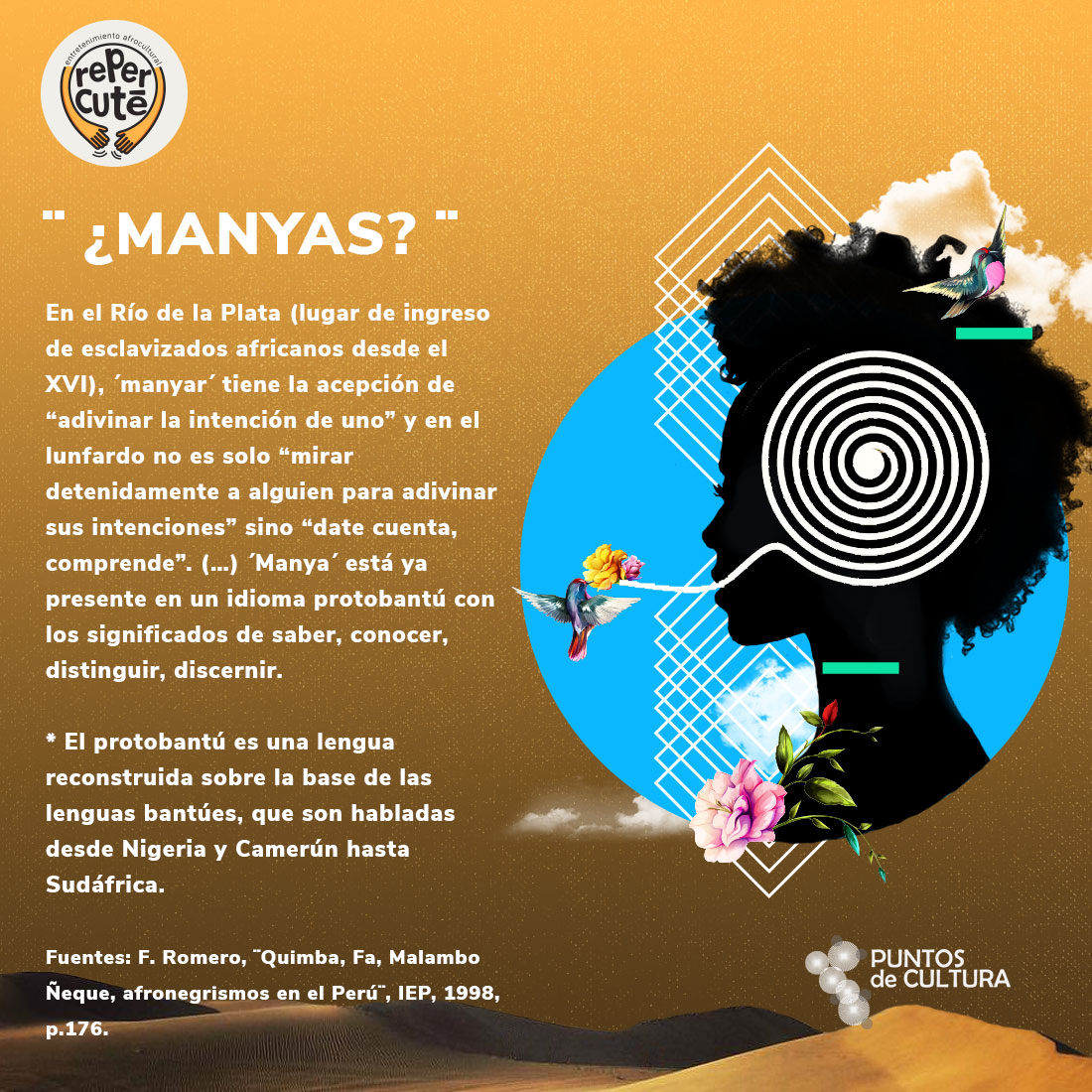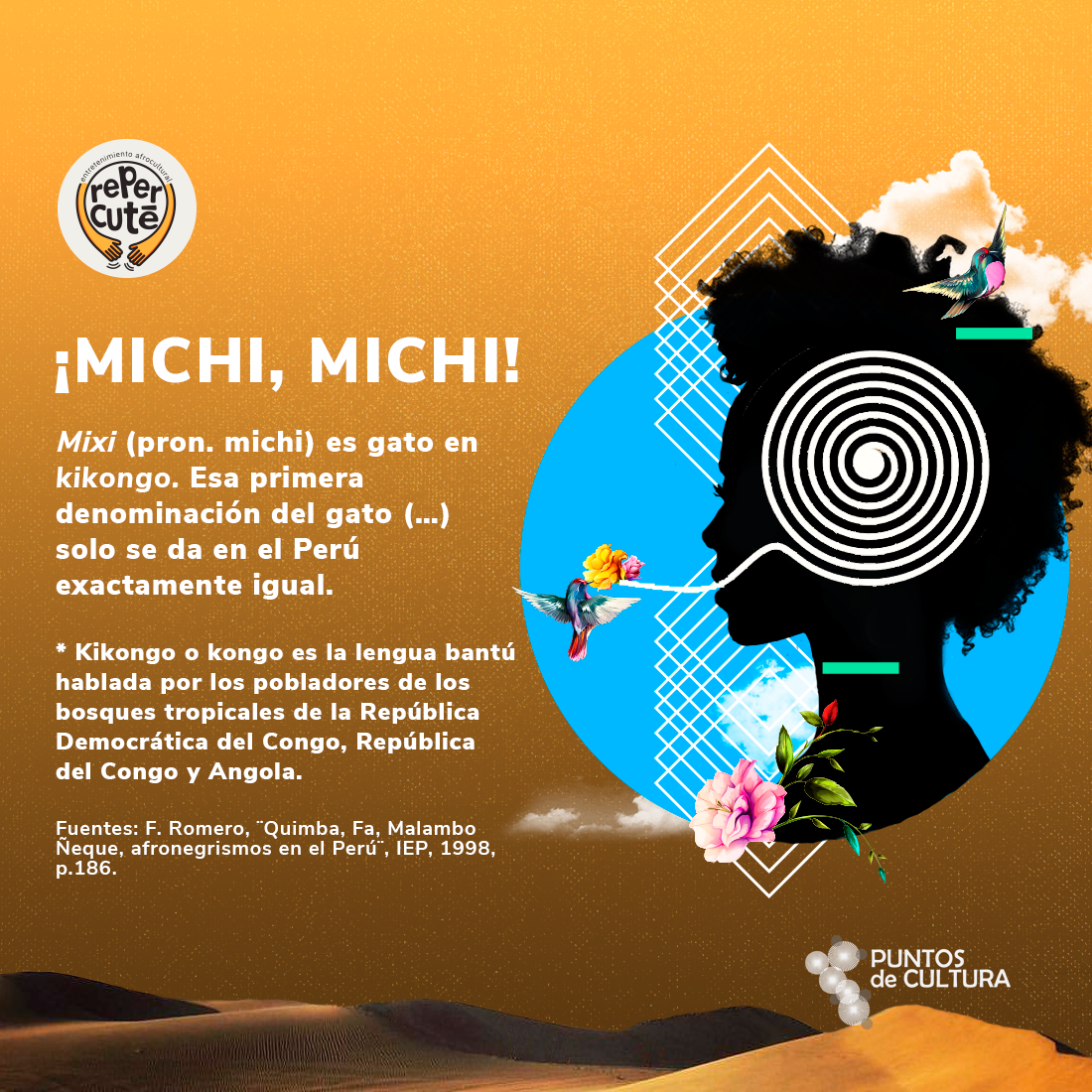Afroperuana kawsay yachayninchikmanta raymichakuy killapi qallarisqa, 2020 watapi, kay ¿Afro yacharqankichu…? sutiyuq qatikuq rimaykunam llapan afro awkinchikkunapa ruwasqankuta, saqiwasqankuta, peru suyunchikta ñawpaqman tanqarisqankuta kusikuywan yuyarichiwanku unaypachamantapacha kanankama willakuykunata , takiy tusuyninchikkunata, siminchikkunata hinallataq huk willakuykunatapas mastarichispa, uqarichispa.
Lancée lors du mois de la culture afropéruvienne 2020, la série thématique ¨Afro savais-tu que..?¨ célèbre les contributions que nos ancêtres ont laissées au fil des ans et qui ont été des pièces fondamentales dans le développement de l’histoire du Pérou, rendant visibles et revendiquant des données historiques, musicales, linguistiques spéciales et curieuses.
Launched during the 2020 Afro-Peruvian Culture Month, the thematic series «Did you Afro know that …?» celebrates the contributions that our ancestors have left over the years and that have been fundamental pieces in the development of the history of Peru, making visible and claiming special and curious historical, musical, linguistic data.
Lingüísticos
¿Sabías que…
La palabra “bolondrón” halla sus antecedentes en los vocablos afronegros bolò (maleza, monte), boloka, bolola (superabundancia, exceso), bombosoko (en mesa), bulolo (gran número, cantidad) y mòolo (desarrollar, crecer mucho y bien). El kimbundu tiene mulundum para “montón de cosas”.
* El kimbundu se habla en Angola
Fuentes: F. Romero, “Quimba, Fa, Malambo Ñeque, afronegrismos en el Perú”, IEP, 1998, p.46.
¿Yacharqankichu…
¡Bolondron hatarikamun!
“Bolondron” rimayqa sapinchasqa kachkan iskay afronegro rimaykunapi: “bolo” (qurakuna, sachakuna), “boloka”, “bolola” (nisyu taqi, sinchi imakuna), “bombosoko” (patacha hawapi), “bulolo” (achkakuna, qaqaykuna) hinallataq ´mòolo´ (ñawpaqman riy, allinpaq wiñay).
Kimbunduqa ancha “mulundum”niyuqmi imaymana ruwaykunapaq.
Willakuq: F. Romero, ¨Quimba, Fa, Malambo Ñeque, afronegrismos en el Perú¨, IEP, 1998, p.46. / “Quimba, fa, Malambo Ñeque, afroyanarimaykuna Peru suyupi” IEP, 1998, p.46.
Savais-tu…?
…que le mot «bolondrón» trouve ses antécédents dans les mots africains «bolò» (herbe, forêt), «boloka», «bolola» (surabondance, excès), «bombosoko» (sur table), «bulolo» (grand nombre, quantité ) et ´mòolo´ (se développer, grandir beaucoup et bien). Le kimbundu a «mulundum» pour «beaucoup de choses».
* Le kimbundu est parlé en Angola
Sources: F. Romero, ¨Quimba, Fa, Malambo Ñeque, afronegrismos en el Perú¨, IEP, 1998, p.46.
Did you know that…
….the word ´bolondrón´ finds its antecedents in the black words ´bolò´ (weed, forest), ´boloka´, ´bolola´ (superabundance, excess), ´bombosoko´ (on table), ´bulolo´ (large number, quantity ) and ´mòolo´ (develop, grow a lot and well). Kimbundu has ‘mulundum’ for ‘lots of things’.
* Kimbundu is spoken in Angola
Sources: F. Romero, ¨Quimba, Fa, Malambo Ñeque, afronegrismos en el Perú¨, IEP, 1998, p.46.
¡Se armó un bolondrón!

¿Manyas?

¿Sabías que…
En el Río de la Plata (lugar de ingreso de esclavizadosd africanos desde el XVI), «manyar» tiene la acepción de «adivinar la intención de uno» y en el lunfardo no es solo «mirar detenidamente a alguien para adivinar sus intenciones» sino «date cuenta, comprende», (…) ‘Manya’ está ya presente en un idioma protobantú con los significados de saber, conocer, distinguir, discernir. * El protobantú es una lengua reconstruida sobre la base de las lenguas batúes, que son habladas desde Nigeria y Camerún hasta Sudáfrica
Fuentes: F. Romero, “Quimba, Fa, Malambo Ñeque, afronegrismos en el Perú”, IEP, 1998, p.176.
¿Yacharqankichu…
¿Manyas?
Rio de la Platapi (siglo XVIpi yaykuy punku llapan munaynin qichusqa africanukunapa), chaypim ´manyar´ rimayqa “huk munasqanta musyay” ninanmi, hinallataq lunfardo simipiqa manallam “huk munasqanta musyanapaq qasilla unayta qawaykuy” kakun, aswantaq “yuyaymanakuy, yachakuy”. (…) ´Manya´ rimayqa huk protobantú simipipas kachkanmi, chaypi ninami: yachakuy, yuyaymanakuy, rikukuy, hamutakuy ima.
*Protobantú kan huk musuqmanta kawsarichisqa simi bantúes simikunamanta, chay simikunaqa Nigeria hinallataq Kamerún suyukunamanta Sudafricakama rimakunku.
Willakuq: F. Romero, ¨Quimba, Fa, Malambo Ñeque, afronegrismos en el Perú¨, IEP, 1998, p.176. / / “Quimba, fa, Malambo Ñeque, afroyanarimaykuna Peru suyupi”, ¨, IEP, 1998, p.176.
Savais-tu…?
… que à Río de la Plata (lieu d’entrée des esclaves africains depuis le XVIe siècle), «manyar» a le sens de «deviner l´intention de quelqu´un» et en lunfardo ce n’est pas simplement «regarder de près quelqu’un pour deviner ses intentions» mais «Réalise ! Comprend !». (…) «Manya» est déjà présent dans une langue proto-bantoue avec les significations de savoir, connaître, distinguer, discerner.
* Le proto-bantou est une langue reconstruite sur la base des langues bantoues, qui sont parlées du Nigéria et du Cameroun à l’Afrique du Sud.
Sources: F. Romero, ¨Quimba, Fa, Malambo Ñeque, afronegrismos en el Perú¨, IEP, 1998, p.176.
Did you know that…
… in the Río de la Plata (place of entry for enslaved Africans since the 16th century), ´manyar´ means “guessing one’s intention” and in lunfardo it is not just “looking closely at someone to guess his intentions” but «realize, understand» (…). ´Manya´ is already present in a proto-Bantu language with the meanings of knowing, knowing, distinguishing, discerning.
tinguir, discernir.
* Proto-Bantu is a language reconstructed on the basis of the Bantu languages, which are spoken from Nigeria and Cameroon to South Africa.
Sources: F. Romero, ¨Quimba, Fa, Malambo Ñeque, afronegrismos en el Perú¨, IEP, 1998, p.176.
¿Sabías que…
La palabra “tocayo” halla sus antecedentes en los vocablos kikongo toka que significa: número par, juego de adivinar par o impar y como adjetivo significa: par. El afijo yó corresponde al significado “con, tanto, como” y en el norte del país significa “un cierto hombre”.
* Kikongo o kongo es la lengua bantú hablada por los pobladores de los bosques tropicales de la República Democrática del Congo, República del Congo y Angola.
Fuentes: F. Romero, ¨Quimba, Fa, Malambo Ñeque, afronegrismos en el Perú¨, IEP, 1998, p.261.
¿Yacharqankichu…
´Tocayo´ rimaypaqa wamaqnin kaqkuna tarikun Kikongo simipa ´toka´ rimayninpi, chayqa “kinti yupaykuna, kinti utaq chulla yupaykunata watuy, hinallataq “kaqlla” ninanpas. Afijo ´yó´ nisqataq “ kaywan, chaynallataq” niyta munan, hinallataq suyunchik hanayninpi “huk runas” niyta munan.
* Kikongo utaq kongo kan bantú simi, kayqa República Democrática del Congo, República del Congo chaynallataq Angola suyukunapa yunkankunapi tiyaq runakunapa rimasqan simim.
Willakuq: F. Romero, ¨Quimba, Fa, Malambo Ñeque, afronegrismos en el Perú¨, IEP, 1998, p.261. / “Quimba, fa, Malambo Ñeque, afroyanarimaykuna Peru suyupi”. IEP, 1998, p.261.
Savais-tu…?
… que le mot «tocayo» trouve ses antécédents dans le mot kikongo «tooka» qui signifie «nombre pair, jeu de devinettes pair ou impair» et, comme adjectif, «pair». L’affixe «yo» correspond à «avec, comme»; et dans le nord du pays à «un certain homme».
* Le kikongo ou kongo est la langue bantoue parlée par les habitants des forêts tropicales de la République démocratique du Congo, de la République du Congo et de l’Angola.
Sources: F. Romero, ¨Quimba, Fa, Malambo Ñeque, afronegrismos en el Perú¨, IEP, 1998, p.261.
Did you know that…
… the word ´tocayo´ finds its antecedents in the Kikongo words ´toka´ which means ¨even number, even or odd guessing game¨ and, as an adjective, ¨pair¨. The affix ´yo´ corresponds to ¨as, like, by way of¨; and in the north of the country to ¨a certain man¨.
* Kikongo or Kongo is the Bantu language spoken by the people of the tropical forests of the Democratic Republic of the Congo, the Republic of the Congo and Angola.
Sources: F. Romero, ¨Quimba, Fa, Malambo Ñeque, afronegrismos en el Perú¨, IEP, 1998, p.261.
Es mi tocayo

¡Michi, michi!

¿Sabías que…
Mixi (pron. michi) es gato en kikongo. Esa primera denominación del gato (…) solo se da en el Perú exactamente igual. *Kikongo es la lengua bantú hablada por los pobladores de los bosques tropicales de la República Democrática del Congo, República del Congo y Angola.
Fuente: F. Romero, ¨Quimba, Fa, Malambo Ñeque, afronegrismos en el Perú¨, IEP, 1998, p.186.
¿Yacharqankichu…
´Mixi´ (pron. michi) rimay, kikongo simipiqa misi ninanmi. Chay wamaq rimay misita sutichanapaq (…) Peru suyullapi kaqllata tarikun.
* Kikongo utaq kongo kan bantú simi, kayqa República Democrática del Congo, República del Congo chaynallataq Angola suyukunapa yunkankunapi tiyaq runakunapa rimasqan simim.
Willakuq: F. Romero, ¨Quimba, Fa, Malambo Ñeque, afronegrismos en el Perú¨, IEP, 1998, p.186. / “Quimba, fa, Malambo Ñeque, afroyanarimaykuna Peru suyupi”. IEP, 1998, p.186.
Savais-tu…?
… que «Mixi» (pron. michi) est un chat en kikongo. Cette première dénomination du chat (…) n’apparaît exactement de la même manière qu’au Pérou.
* Le kikongo ou kongo est la langue bantoue parlée par les habitants des forêts tropicales de la République démocratique du Congo, de la République du Congo et de l’Angola.
Sources: F. Romero, ¨Quimba, Fa, Malambo Ñeque, afronegrismos en el Perú¨, IEP, 1998, p.186.
Did you know that…
….´Mixi´ (pron. Michi) is cat in Kikongo. That first denomination of the cat (…) only occurs exactly the same in Peru.
* Kikongo or Kongo is the Bantu language spoken by the people of the tropical forests of the Democratic Republic of the Congo, the Republic of the Congo and Angola.

